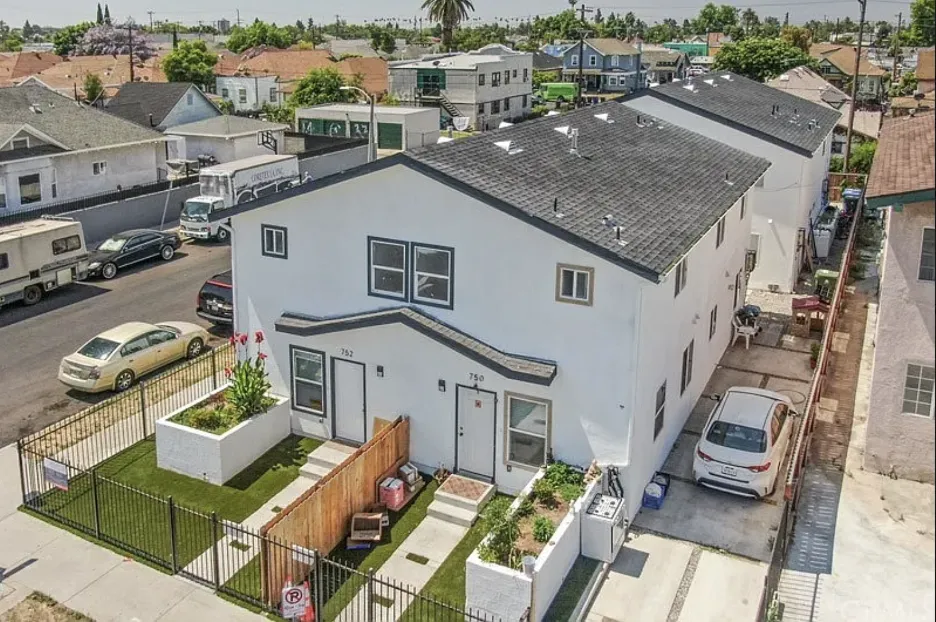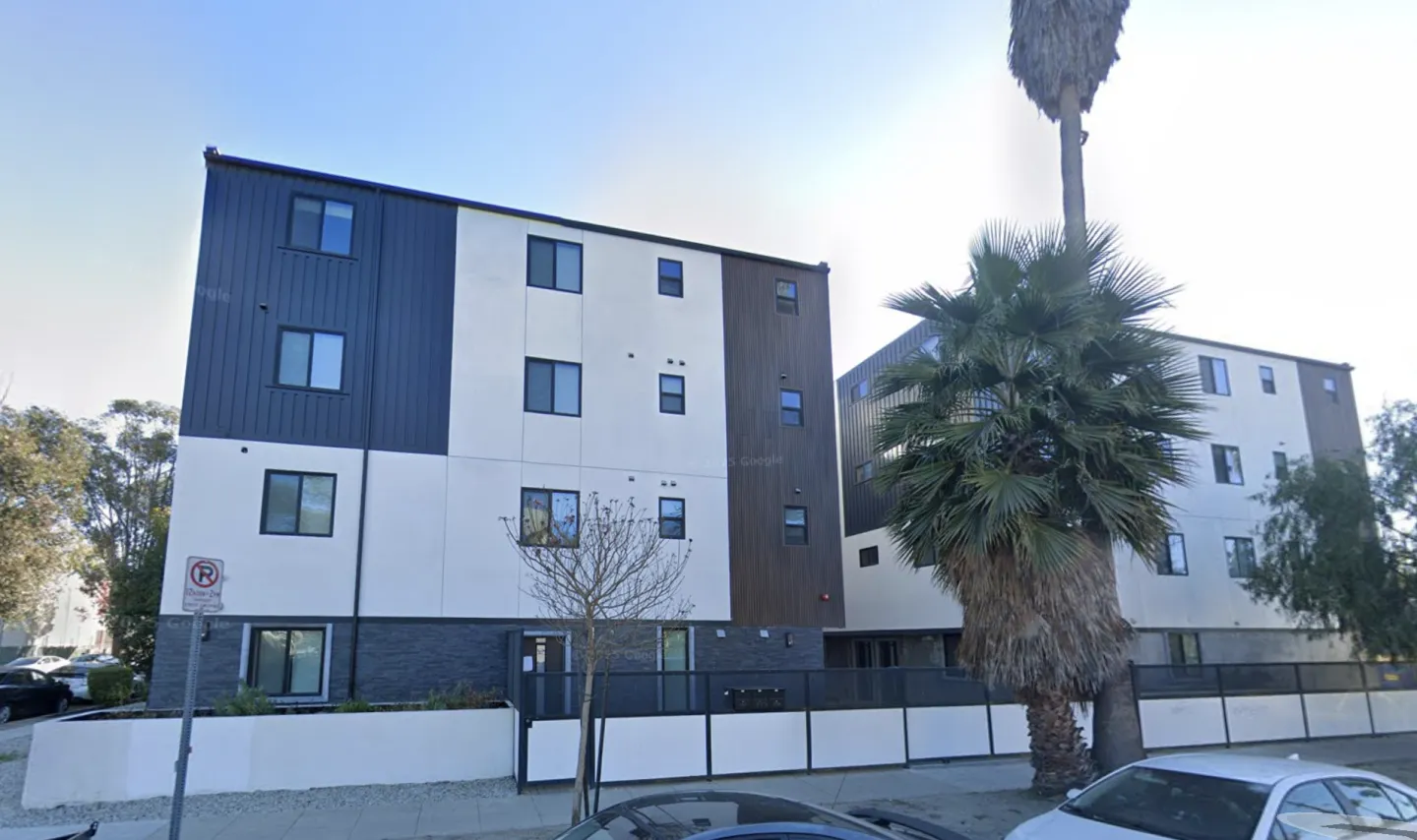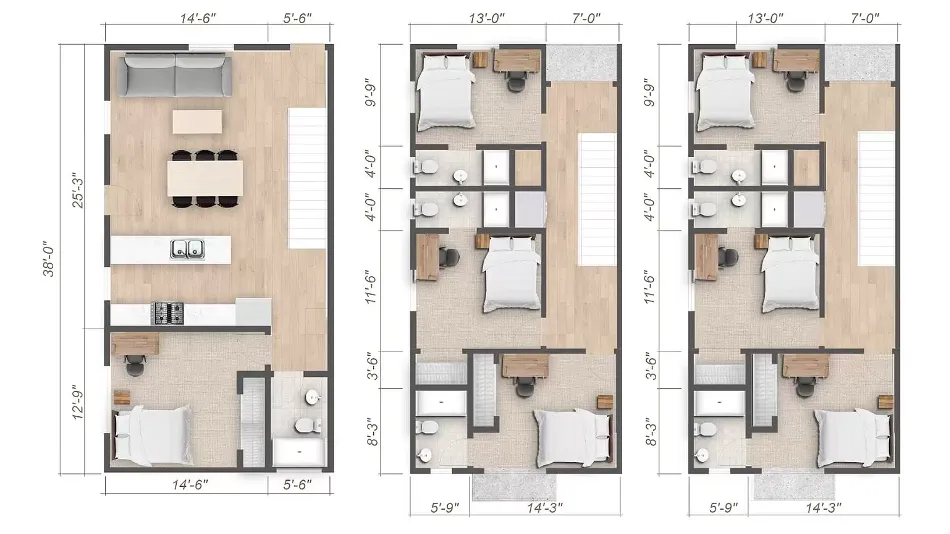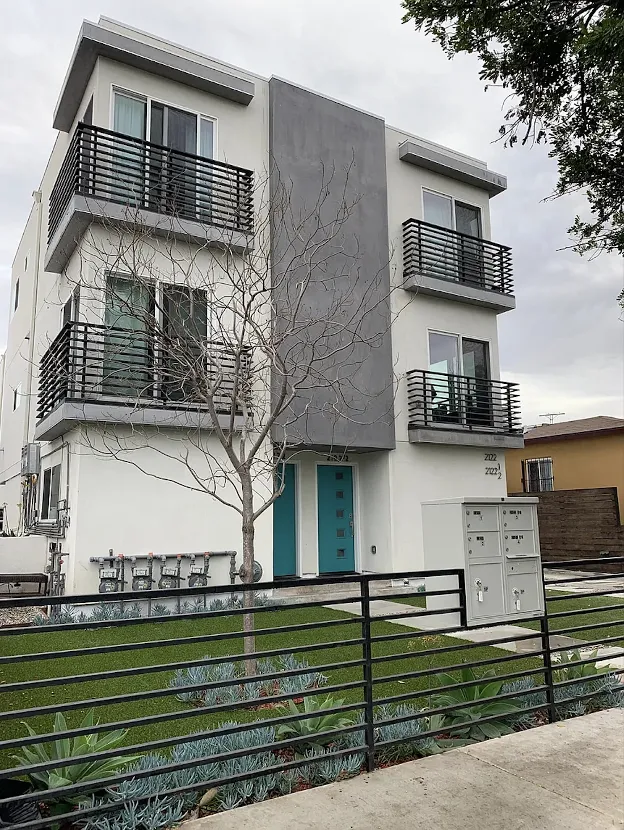- | Housing Housing
- | Policy Briefs Policy Briefs
- |
The Double Duplex: One Response to Los Angeles’s Overcrowding Crisis
A fast, affordable housing model for LA renters—with the potential to meet broader housing needs
Introduction
Even before the January 2025 fires, Los Angeles (LA) was suffering from an acute housing shortage, which resulted in high housing costs and overcrowding.[1] According to 2023 census data, about 16 percent of renter-occupied homes in Los Angeles County were classified as overcrowded—one of the highest rates in the country.[2] This issue is more pronounced in specific LA neighborhoods, such as Koreatown and Pico-Union (90006 ZIP Code) and Boyle Heights (90033 ZIP Code), with overcrowding rates of 34 percent and 28 percent, respectively. To afford housing and living expenses, many residents share multibedroom units with unrelated individuals, renting housing by the bedroom rather than by the unit.
Overcrowding and housing affordability problems have led to a new development type in Los Angeles, the double duplex (figure 1). Unlike traditional multifamily housing or small-lot subdivisions, the double duplex consists of two large duplexes on a single property, with four units total. Each unit offers up to seven bedrooms and a similar number of bathrooms, which makes them well suited to be rented by the bedroom. This mode of renting is further evidenced by the disproportionately high per-unit rental costs of double duplexes, results from contractor interviews, and marketing language used in double duplex listings: a Zillow listing for 1635 E. 33rd St. #2 advertises a “secure co-living environment” and urges prospective applicants to “reserve [their] bed now.”[3] As a result, these developments can function as co-living facilities or de facto single-room occupancy (SRO) housing, a housing style that has been outlawed in many areas across the country for approximately 50 years. However, because of quirks in LA’s zoning code, double duplexes have emerged to meet the demand for readily available and more affordable shared living arrangements. As of 2023, more than 500 double duplex complexes have been permitted in the city.
FIGURE 1. An example of a double duplex

Note: This double duplex is located at 750 E. 32nd St., Los Angeles. These two structures contain 17 bedrooms and 12 bathrooms.
Source: Photo courtesy of Zillow, https://www.zillow.com/homedetails/750-E-32nd-St-Los-Angeles-CA-90011/95530661_zpid/.
Double duplexes play an important role in the LA housing ecosystem by addressing the need for more bedrooms in high-density areas and providing an option for renters who are willing to sacrifice some luxuries to secure housing they can afford. This willingness to compromise aligns with an increasing national trend of unrelated individuals living together to reduce expenses.[4]
Los Angeles’s chronic housing shortage has led to severe overcrowding, particularly in low-density neighborhoods, where renters struggle to find affordable options. This policy brief analyzes the role of the double duplex in Los Angeles’s housing ecosystem (figure 2). By outlining the regulatory framework that enables their construction, the financial and logistical incentives driving their development, and their impact on housing affordability, the authors aim to provide an objective overview.
FIGURE 2. Most crowded LA ZIP codes containing at least three double duplexes

Note: This figure shows the proportion of all renter-occupied units in ZIP Codes that contain at least three double duplexes, in which the number of occupants exceeds the overcrowding threshold of more than one person per room. The ZIP Codes’ general geographic descriptions are as follows: Koreatown and Pico-Union (90006), Boyle Heights (90023), Southeast Los Angeles (90011), Boyle Heights (90033), South Los Angeles (90037), North Hollywood (91605), East Hollywood (90029), and Van Nuys (91406).
Source: US Census Bureau, 2023 ACS 5-Year Estimates §B25014.
A Stopgap Option
Double duplexes offer a housing stopgap between single-family and multifamily construction in a city where multifamily development is costly and slow to build. Even though double duplexes require a series of regulatory loopholes and come with tradeoffs for occupants, a huge market demand exists for them, suggesting a need for more streamlined approaches for constructing multiple-unit multifamily housing. The existence of double duplexes is indicative of a zoning failure, with most double duplexes being built in historically multifamily areas that were downzoned in the 1980s to maintain single-family homes in Los Angeles. Although double duplexes present an immediate solution for people priced out of traditional rental markets, they also raise important questions about land use efficiency, tenant experience, and long-term urban planning goals. This commentary seeks to shed light on the legal and economic conditions that have made double duplexes a viable housing option, offering a comprehensive analysis to inform policymakers, planners, and housing advocates. See figure 3 for an example of a duplex with private bathrooms in each unit that caters to students.
FIGURE 3. 18-bedroom, 18-bathroom double duplex structure
a. Street view

b. Floor plan

Note: This double duplex, which primarily caters to students, is located at 3737 S. Catalina St., Los Angeles.
Source: Photo courtesy of Zillow, https://www.zillow.com/homedetails/3737-S-Catalina-St-Los-Angeles-CA-90…?.
How Double Duplexes Became a Legal Housing Construction Type
A mixture of historical, legal, and economic factors led to the accidental creation of double duplexes. The majority of double duplexes in LA are being built on lots zoned as RD1.5, which stands for “restricted development.” This zone type was established in 1964 as part of an attempt to downzone land that was previously zoned for higher-density uses. Although the RD1.5 zone imposes restrictions on density, it allows relatively generous height and floor area ratio (FAR) limits that allow developers to build larger units than otherwise possible on single-family lots (see figure 4).[5]
FIGURE 4. 12-bedroom, 13-bathroom double duplex structure

Note: This high-occupancy double duplex is located at 2122 Carmona Ave., Los Angeles.
Source: Photo courtesy of Zillow, https://www.zillow.com/homedetails/2122-Carmona-Ave-2122-Los-Angeles-CA-90016/2079362869_zpid/.
More recent legislation has also contributed to double duplex developments. In 2008, the City of Los Angeles passed the Baseline Mansionization Ordinance (BMO) in an effort to curb mansion development in low-density neighborhoods.[6] The BMO reduced the minimum FAR and eliminated all residential floor area bonus options in all zones slated for single-family development only. It also eliminated or restricted some residential floor area exemptions for single-family zones; however, its restrictions did not apply to multiunit projects, including duplexes. This omission allowed contractors experienced and licensed in mansion construction to seamlessly transition to larger projects using the California Residential Code (CRC), which applies the same building code standards to duplexes as it does to single-family homes. The CRC covers one- and two-family dwellings and townhouses up to three stories. By contrast, the California Building Code (CBC) governs all other multifamily buildings, including medium- and high-density housing, often introducing complexities and costs that can hinder or prevent development of small-scale multifamily homes.[7]
Double Duplex Advantages over Traditional Multifamily Housing
To understand the reasons that builders may be interested in building this type of housing, we interviewed three double duplex developers who have designed and built these structures. They shared two main reasons: double duplexes often involve less red tape and are less expensive to build than traditional multifamily construction.
First, a majority of double duplexes are classified under the R-3 building occupancy category in the building code, which means they undergo a more streamlined residential inspection governed by the CRC. By contrast, a typical multifamily CBC property has multiple inspectors for different aspects of the development, necessitating coordination among the various inspectors and leading to longer, sometimes multiyear development timelines. The CRC’s single-inspector requirement allows double duplex projects to be inspected in a single visit, thereby reducing the additional costs and time delays associated with multifamily housing.
In addition, double duplexes typically are built using type V-B construction, a less expensive construction method that permits the use of exposed wood and is typical for single-family homes.[8] By contrast, traditional multifamily housing often requires type V-A construction, which, although more fire resistant, is also significantly more costly owing to its restrictions on exposed materials.[9]
Double duplexes are also eligible for a variety of planning exemptions and streamlining processes, including by-right rather than ministerial processes.[10] By-right status means developers are able to receive a certificate of occupancy by pulling permits from the city building department instead of having to go through a longer approval process of ministerially entitling a project through the planning department or zoning administrators. Partly because of this expedited process, development time for double duplexes tends to be significantly faster, with an average time to build from permit issuance to certificate of occupancy of 444 days[11] compared with the average of 801 days[12] required to build a traditional multifamily project.
In addition, several LA planning requirements apply only to developments with five or more units, which allows double duplex projects to bypass them. Common planning requirements for multifamily properties are covenanted, restricted units that are inclusionary and affordable, private and public open space requirements;[13] on-site trees;[14] low-impact development;[15] and more. As a result of these exceptions, developers, especially those accustomed to single-family construction, perceive double duplexes as less complicated to construct than traditional multifamily housing.
Developers exhibit a preference to build double duplexes even in higher-density zones, where they could elect to pursue multifamily housing instead. As shown in figure 5, slightly more than one-third of all double duplexes are constructed on land zoned for higher-density multifamily housing (specifically zones C2, R3, and R4).[16] In those cases, developers are opting for double duplexes instead of building new higher-density multifamily projects, resulting in a missed opportunity to build more housing units overall.
Cost Savings for Renters and Permanent Supportive Housing Providers
Double duplexes are particularly effective in meeting the housing needs of students, residents in overcrowded neighborhoods, and other renters seeking affordable options. Lower-income renters often split costs by renting individual rooms and sharing common spaces, such as bathrooms, kitchens, and laundry facilities. On a per-room basis (comparing a double duplex bedroom to a private for-rent studio), double duplexes typically offer substantially lower rents, with a median monthly savings of $320 including a private bathroom ($1,183 vs. $1,503).[17] The median room rent for double duplexes also falls below the Los Angeles Housing Department’s maximum allowable rents for most tiers of Schedule I affordable housing[18] and below the Moderate tier of Schedule VI affordable housing in Los Angeles.[19]
In some cases, the double duplex model can act as an alternative housing option for renters and organizations seeking more affordable new construction for various purposes. For example, a double duplex has been used to provide housing for unhoused Native Americans: In 2023, the nonprofit United American Indian Involvement acquired a 30-bedroom co-living complex for this purpose.[20] One broker interviewed stated that this housing type is also great for larger religious families who have more children than bedrooms available in the market. In 2024, following an encampment sweep, the Los Angeles Homeless Services Authority leased a triplex by the bedroom to house 20 homeless people.[21] By mid-2025, the Los Angeles Homeless Services Authority and People Assisting The Homeless had master-leased 13 double duplexes, housing nearly 300 formerly unhoused residents.[22] Other potential social uses of double duplexes are still being explored.
Tradeoffs of the Double Duplex Model
The double duplex housing model, although offering affordability advantages, comes with notable drawbacks that may limit its appeal and effectiveness as a long-term housing solution. A key concern is the lack of accessibility within the units. These developments are exempt from some Americans with Disabilities Act provisions owing to their classification under the California Residential Code rather than the more stringent California Building Code. Although this distinction can help reduce construction costs, it also creates housing that is inaccessible to individuals with disabilities. This exclusion not only limits the pool of potential renters but also underscores the inequities inherent in prioritizing cost-saving measures over inclusivity.
In addition, renting by the bedroom frequently requires double duplex tenants to share their living space with unchosen strangers, leading to challenges related to privacy, security, and compatibility. Shared common areas, such as kitchens and bathrooms, can quickly become overcrowded or poorly maintained, particularly when clear guidelines for use and upkeep are absent from management. This disadvantage is also present in other living situations with strangers and is not a phenomenon specific to double duplexes.
According to developer observations, some developers of double duplexes may prioritize designs that maximize the number of bedrooms over those that create functionality, resulting in cramped layouts, limited storage, and an overall reduction in livability compared with more traditional housing options.
From an urban planning perspective, double duplexes represent a missed opportunity to address housing shortages more effectively. By focusing on lower-density projects, these developments often fail to fully use land in zones designated for higher-density, multifamily housing that allow for multiple units with separate kitchens or more family-centered housing units. Building double duplexes on such land forfeits the potential to create significantly more housing units. In addition, the transient nature of tenants who typically occupy double duplexes—often students or short-term renters—contributes to challenges in property maintenance and turnover. High tenant turnover can strain the upkeep of shared spaces because landlords or temporary residents may deprioritize long-term care. This situation can lead to deteriorating property conditions that negatively affect both the residents and the surrounding community, thereby undermining the potential benefits of these developments. Although the double duplex model addresses certain immediate housing needs, its limitations highlight the need for more thoughtful and long-term approaches to urban housing challenges.
Recommendations
To sustain and scale double duplex development in a way that maximizes its benefits while addressing its shortcomings, policymakers should consider targeted reforms:
- Publish through the International Code Council new code guidelines specifically for “missing middle” housing types, a housing model that does not fit squarely as a single-family residential or a large multifamily building, such as double duplexes.
- Adopt by-right multifamily development pathways that would reduce permitting delays and accelerate multiunit housing delivery.
- Codify the right of individuals to share housing regardless of familial or legal relationships.
- Remove arbitrary limits on the number of bedrooms or sleeping areas within a residential unit.
- Increase the number of kitchen facilities allowed per housing unit to facilitate shared kitchen arrangements.
- Adopt measures to streamline the conversion of single-family residences into homes for single-room occupancy. For example, in 2024, the state of Oregon legalized similar housing types in all residential zones.[23]
- To improve the long-term viability of these properties, ensure better oversight through tenant protections and property management standards that address maintenance issues, safety, and accessibility concerns.
Conclusion
The double duplex has emerged as a practical response to Los Angeles’s housing crisis, providing a fast, cost-effective way to add bedrooms in a city where overcrowding is widespread. By taking advantage of single-family zoning quirks and regulatory loopholes, these developments supply much-needed housing for renters who might otherwise struggle to find affordable options. Double duplexes have proved especially useful in areas with high student populations and in neighborhoods where large households or co-living arrangements are already common. In addition, their streamlined approval process and lower construction costs make them an attractive option for small and midsized developers, who might not have the resources to take on larger multifamily projects. In some cases, double duplexes have also been used to house vulnerable populations, such as homeless individuals, demonstrating double duplexes’ potential as a flexible housing solution. Some renters prefer this type of housing option.
However, areas for improvement are clear. The current model prioritizes bedroom count over livability, possibly resulting in cramped layouts, inadequate storage, and shared spaces that can lead to quality-of-life concerns. In addition, these units lack accessibility features, thus excluding tenants with mobility impairments. The fact that many double duplexes are built on land zoned for higher-density housing also raises concerns about land use efficiency; when developers choose to build double duplexes instead of higher-density multifamily housing, the city loses an opportunity to create more homes in the long term and to collect additional property taxes in places that lack overall housing supply.
Double duplexes have the potential to serve as a tool in California’s broader housing strategy to reduce overcrowding and to enable more rental options. By refining the model to balance affordability, livability, and urban planning goals, the city could embrace the double duplex model to provide much-needed housing without compromising on quality or long-term development capacity. Instead of being seen as a temporary stopgap or an emergent way to work around zoning laws, double duplexes provide an additional option for renters.
About the Authors
Valerie Wilke is an environmentalist and housing advocate currently serving as a Sustainability and Innovations Fellow at the City of Ann Arbor, where she guides long-term climate and energy strategy. She previously served as the Policy Supervisor for Intern Affairs at the Livable Communities Initiative in Los Angeles and conducted voter outreach for the Progressive Turnout Project and the Michigan League of Conservation Voters. She holds a BS from the University of Michigan.
Eduardo Mendoza is a policy and research analyst at California YIMBY, where he leads model legislation efforts and supports state-sponsored housing reforms. He previously served as Policy Director at the Livable Communities Initiative and has been active in local and state housing advocacy, with a focus on zoning reform, permitting modernization, and inclusive housing policy. Eduardo holds a Master’s in Urban Planning from USC and serves on the board of Abundant Housing Los Angeles.
Muhammad T. Alameldin is the Senior Policy Advisor at California YIMBY, where he leads research efforts and shapes long-term policy planning, including the development of its five-year legislative agenda. Prior to joining California YIMBY, Alameldin was a Policy Associate at UC Berkeley’s Terner Center for Housing Innovation, where he authored multiple papers and helped influence housing policy across local, state, and federal levels. He also served as a policy advisor to BuildCasa, a leading prop-tech startup and currently serves on the board of the Casita Coalition and the Rockridge Community Planning Council.
Appendix
Methods
To assemble the list of double duplex addresses for the dataset, we examined the Los Angeles County assessor’s 2021 parcel roll database and applied a set of filters to detect properties with double duplex characteristics. Those filters included a minimum square footage of 3,000, a minimum bedroom count of eight, a minimum bathroom count of six, a date of construction in or after 2015, and a location within the tax rate boundaries of Los Angeles County. In addition, we also reviewed the Los Angeles Department of Building Services’ building permit registry using a similar set of filters to gather data for properties that were permitted or built after the assessor’s 2021 parcel roll was published.
To determine which of these addresses were truly double duplexes, we queried addresses in Google Street View, real estate websites, and the Los Angeles Department of Building Services (LADBS) permit database to check for visual or numerical evidence of double duplex status as determined by unit and building count. The addresses of these structures were recorded along with basic information, such as square footage and bedroom and bathroom count. To calculate time to build for each double duplex, we queried its address in the LADBS permit database and measured the number of days between the issuance of a new construction permit and the issuance of a certificate of occupancy. This metric of time to build is consistent with established literature.[24] One important limitation of the method used for gathering descriptive quantitative data about double duplexes was that reliable data were unavailable for most attributes of double duplexes built after 2021, so with the exception of year built and time to build, all figures described in the results section apply only to double duplexes built from 2015 to 2021.
To request interviews with contractors as a source of qualitative data about the double duplex market, we sent a standardized script to each contractor associated with a double duplex from the pre-2022 dataset using company phone numbers obtained from public records. The script contained questions about the estimated cost and time to build a new double duplex, as well as a question about how many double duplexes the contractor had worked on previously. If a contractor accepted the request and agreed to an interview, we arranged a phone interview and took notes on the contractor’s responses.
Financial data for the double duplexes, such as monthly rent and sale price, were pulled from several leading real estate websites, including Zillow, Redfin, Trulia, and Realtor.com. Those values were then adjusted for inflation on the basis of the property’s certification date using a composite scalar derived from the Consumer Price Index in December of each year and the January 2024 Consumer Price Index for shelter. Comparison rent and overcrowding data for all renter-occupied housing in LA was gathered from the US Census Bureau’s American Communities Survey.
Data
Data are found at the master data table link: https://docs.google.com/spreadsheets/d/1Bcxvm7m DQrpWl740tRMUjKADbZ5hLhdvskI-u3gu5vQ/edit?usp=sharing.
Notes
[1] According to the US Census Bureau, overcrowding in housing is defined as a housing unit with more than one person per room, excluding bathrooms, kitchens, hallways, and closets. Severe overcrowding occurs when a unit has more than one and one-half persons per room. California Department of Housing and Community Development, “Overpayment and Overcrowding,” https://www.hcd.ca.gov/planning-and-community-development/housing-eleme….
[2] Brittny Mejia et al., “L.A.’s Love of Sprawl Made It America’s Most Overcrowded Place. Poor People Pay a Deadly Price,” Los Angeles Times, October 19, 2022.
[3] The Zillow listing was at https://www.zillow.com/homedetails/1635-E-33rd-St-2-Los-Angeles-CA-9001….
[4] Richard Fry, “More Adults Now Share Their Living Space, Driven in Part by Parents Living with Their Adult Children,” Pew Research Center, January 31, 2018.
[5] RD1.5 zones have a maximum height of 45 feet, a development FAR of 3:1, and setback requirements of 15 feet for the front and rear and 5 feet for the sides.
[6] Department of City Planning, “Baseline Mansionization Ordinance (BMO) and Baseline Hillside Ordinance (BHO): Code Amendment, Q&A,” City of Los Angeles, August 31, 2016, https://planning.lacity.gov/ordinances/docs/baseline/QandA_4.pdf.
[7] David Garcia et al., “Making Missing Middle Pencil: The Math Behind Small-Scale Housing Development” (report, Terner Center for Housing Innovation, University of California, Berkeley, June 2024).
[8] City and County of San Francisco, “Building Construction Type Definitions: Type V-B: Unprotected Wood Frame,” https://www.sf.gov/information/building-construction-type-definitions.
[9] WoodWorks, “Key Design Considerations for Mass Timber Projects,” web page, accessed July 31, 2025, https://www.woodworks.org/resources/keydesign-considerations-for-mass-timber-projects/.
[10] The by-right process (two units and fewer) is more streamlined than the ministerial process (50 units and fewer) in the City of Los Angeles.
[11] Calculated from manual analysis of LA County Assessor’s Office data.
[12] California Annual Progress Report, filtered by developments in Los Angeles County with at least five units.
[13] Los Angeles Municipal Code (LAMC) §12.21.(G)(2).
[14] LAMC §12.21.(G)(2)(a)(3).
[15] LAMC §64.72.05.(B); LAMC §64.72.(C).
[16] The maximum density in units per acre for each zone is as follows: RD1.5 is 29, RD2 is 21.8, R3 is 54.5, R4 is 109, and C2 is 109.
[17] U.S. Census Bureau, (Los Angeles County) American Community Survey (ACS) 5-Year Estimates, Table B25031.
[18] An exception is the “extremely low” ($729) income tier. “Los Angeles Housing Department (LAHD), 2024 Income and Rent Limit—Land Use Schedule I, 2024,” effective July 1, 2024, https://housing.lacity.gov/wp-content/uploads/2024/07/2024-Land-Use-Income-and-Rent-Schedules-Schedule-I.pdf.
[19] “LAHD, 2024 Income and Rent Limit—Land Use Schedule VI,” effective July 1, 2024, https://housing.lacity.gov/wp-content/uploads/2025/02/Sch.-6-ALI-2024-updated.pdf.
[20] Lydia Pantazes, “Housing Aimed at Helping Native Americans,” Spectrum News 1, October 6, 2022.
[21] Doug Smith and Angie Orellana Hernandez, “How Student Housing Around USC Is Transforming a Historic Black and Latino Neighborhood,” Los Angeles Times, March 20, 2024.
[22] The Los Angeles Homeless Services Authority’s master leasing list is being withheld to protect the privacy of residents but is available by request. Credit to Oren Hadar for first discovering that these buildings are being leased to house the unhoused.
[23] Oregon Legislature, “Single Room Occupancies,” Oregon Revised Statutes, 197A.430, https://oregon.public.law/statutes/ors_197a.430#google_vignette.
[24] Edward Kung and Stuart Gabriel, Tackling the Housing Crisis: Streamlining to Increase Housing Production in Los Angeles (Los Angeles Business Council Institute, 2023).

